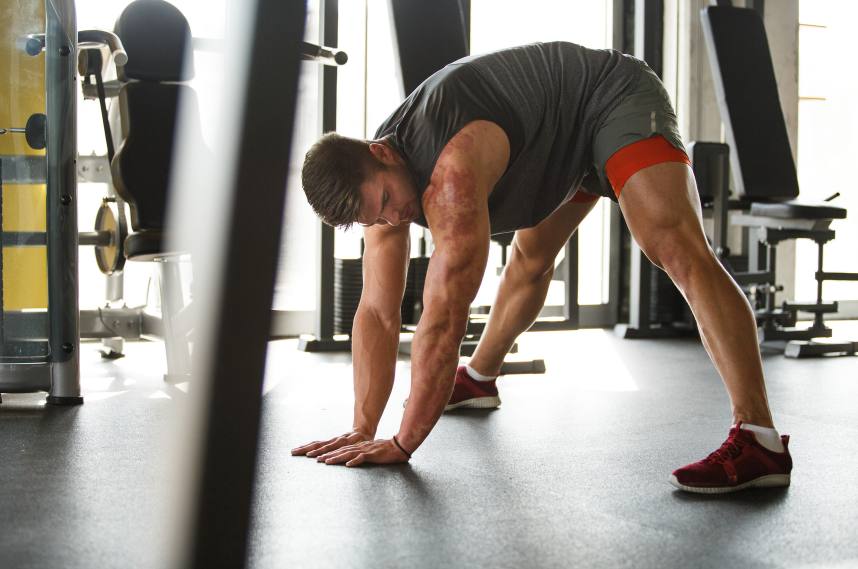Acute hamstring strains are common injuries for many popular sports, including various football codes, hockey, cricket and track and field. Hamstring injuries are the most common injury in Australian rules football, constituting 15% of all injuries, with an incidence rate of 6 injuries per approximately 40 players per season, and a prevalence rate of 21 missed matches per club per season. Similarly, in the English Premier League, hamstring strains make up 12% of all injuries. Acute hamstring strains also have the highest recurrence rate of any injury, a rate of 34% in Australian rules football and 12% in the English Premier League (Brukner & Khan 2015).

There are two types of hamstring strains: Type I and Type II
Type I Acute Hamstring Strains:
Type I hamstrings strains are the more common injury type, which often occur during high speed running. They usually involve the long head of biceps femoris, most commonly at the proximal (upper) muscle-tendon junction. These generally cause a more marked acute decline in function but typically require a shorter rehabilitation period than Type II injuries. Case studies suggest that hamstrings appear to be the most vulnerable during the end of the swing phase of sprinting, where they are highly activated as they work eccentrically to decelerate the swinging tibia (shin) and control knee extension in preparation for foot strike. Symptoms usually consist of a sudden onset of pain in the hamstring region that interrupt the ability to run.
Type II Acute Hamstring Strains:

Type II hamstring strains often occur during movements leading to excessive lengthening of the hamstrings when the hip is in flexion, such as high kicking, slide tackles in soccer or performing the splits. These injuries more commonly occur in sports that require large amplitude movements such as ballet and gymnastics. The common mechanism of injury in these instances is an excessive stretch into hip flexion. These injuries are often located close to the ischial tuberosity (base of the buttocks on the pelvic bone) and can involve the semimembranosus (one of the hamstrings’) tendon. Type II strains often cause a less dramatic acute limitation than Type I strains, though their rehabilitation is often longer. Passive stretching and heavy-load exercises seem to aggravate these hamstring injuries.
Signs and Symptoms:

An acute hamstring strain results in a sudden, minimal to severe pain in the posterior thigh, sometimes with a characteristic “popping” or tearing impression. Swelling and bruising are possible but may not occur for several days after the date of injury. Loss of joint active range of motion in the knee and hip can be apparent as well as decreased strength and length of the injured hamstring. Rarer symptoms can include numbness, tingling, and distal extremity weakness. These symptoms require further investigation into sciatic nerve irritation as a result of either impingement of the nerve or secondary injury. Large hematomas (swollen muscular bruising) or scar tissue can be caused by complete tears and avulsion injuries.
Hamstring strains are categorised in 3 groups, according to the amount of pain, weakness, and loss of motion:
- Grade 1 (mild): just a few fibres of the muscle are damaged or have ruptured. This rarely influences the muscle’s power and endurance. Pain and sensitivity usually happen the day after the injury. Walking is usually able and the knee can still bend normally.
- Grade 2 (medium): approximately half of the fibres are torn. This will influence the muscle’s power and endurance, and can include a limp with gait. There is occasional swelling, often bruising (which may or may not come to the skin surface) and pain which can be reproduced by bending the knee against resistance.
- Grade 3 (severe): ranging from more than half of the fibres ruptured to complete rupture of the muscle. Both the muscle belly and the tendon can suffer from this injury. It causes large swelling, bruising and pain. The function of the hamstring muscle can’t be performed anymore and the muscle shows great weakness.
Prognosis of Hamstring Injuries:
The following factors have been shown to be associated with increased length of time to return to play:

- Time to walk at normal pace pain-free has been shown to be significantly associated with return to play time (>1 day = 4x more likely to take >3 weeks). Combining this with a past history of hamstring injury within 12 months results in a 93% chance of taking longer to return to play.
- Days to jog pain-free is the strongest predictor of time to return to play:
- 1-2 days = < 2 weeks
- 3-5 days = > 2 weeks
- > 5 days = > 4 weeks
- The closer to the ischial tuberosity in a biceps femoris injury, the more prolonged the time to return to pre-injury level.
- Injury to the tendon of the semimembranosus muscle is associated with a recovery period of twice as long of those without tendon injury.
- The length and cross sectional area of the tear results in prolonged return to play.
(Brukner & Khan 2015)
Risk Factors for Acute Hamstring Strains:
Risk factors for a hamstring strain may be intrinsic (patient related) or extrinsic (environment related). Body Mass Index (BMI), height and weight have been ruled out as factors for hamstring strains through the use of functional performance tests.
Intrinsic factors:

- Age: Athletes from older age groups are at an increased risk of an acute hamstring strain. For example in Australian rules football, players older than 23 years of age are 4 times more likely to sustain an acute hamstring injury. This may be related to reduced hip flexor length, but it has also been suggested that it could be in relation to degenerative changes at the lumbosacral (base of the spine) junction.
- Past history: In comparison to injury-free athletes, those with a past history of hamstring injury demonstrate differences in hamstring muscle volume, scar tissue and contraction mechanics. The presence of scar tissue creates higher rates of localised tissue strains in adjacent muscle fibres. Athletes with a history of other lower limb or lower back injuries also have an increased likelihood of sustaining an acute hamstring strain due to changes in the athletes biomechanics.
- Hamstring strength: The ratio between hamstring strength and quadriceps strength has been proven to be influential when analysing increased risk of hamstring injury. Studies have found that weaker hamstrings or stronger quadriceps has proven to be influential in generating risk of an acute hamstring strain.
(Engebretsen et al, 2010).
Extrinsic factors:
- Fatigue: A study by Verrall et al. found that 85% of hamstring injuries occurred after the first quarter of a competitive match or after the first 15 minutes of a training session. In another study Woods et al. found that 47% of acute hamstring strains occurred during the final third of the first and second halves of a match. This evidence is suggestive that fatigue plays a role in hamstring strains, however further studies are required.
- Player position: Goalkeepers have a significantly lower risk of sustaining an acute hamstring strain than outfield players in soccer. In rugby codes, forwards have a considerably lower risk of hamstring strains than players in the backline.
Prevention of Hamstring Strains:

There are a number of studies that support the use of an eccentric strengthening program to reduce the risk of hamstring injury. A study by Petersenet al, found that there was a three-fold reduction in the total number of hamstring injuries and a seven-fold reduction of re-injury for an intervention group when using an eccentric strengthening program. Both groups underwent a 10 week progressive preseason eccentric training program of Nordic (eccentric hamstring loading) exercises. This was then followed by a weekly seasonal program. Another study by Arnason et al, found similar reductions in hamstring strain prevalence when subjecting soccer players to an eccentric/concentric strengthening program.
Proprioceptive exercises or balance training is also an effective strategy for preventing hamstring injuries. In a study by Kraemer et al, 24 elite female soccer players performed an additional soccer-specific proprioceptive multistation program over three years with difficulty progressions. At the conclusion of this program it was found that non-contact acute hamstring strains had reduced in occurrence from 22.4 to 8.2/1000 hours of game and training time.
Soft tissue therapy has been shown to be effective at reducing lower limb muscle strains in general. Hoskins and Pollard found that acute hamstring strains in semi-elite Australian rules footballers were reduced with a soft tissue therapy program. The program had a minimum scheduling of 1 treatment per week for 6 weeks, then 1 treatment per fortnight for 3 months and then 1 treatment per month for the remainder of the season.

Treatment:
Hamstring strain injuries remain a challenge for both athletes and clinicians, given their high incidence rate, slow healing, and persistent symptoms. Nearly 30% of these injuries reoccur within the first year following a return to sport, with subsequent injuries often being more severe than the original.
In the early stages of rehabilitation, physiotherapy will predominantly consist of pain relief via massage, offloading techniques where required and taping. When the hamstring is ready, a Physiotherapist will prescribe a progressive strengthening program which can be implemented in conjunction with hands-on therapy for a speedy recovery. This program will often consist of eccentric exercises for the hamstring as many studies indicate that eccentric muscle loading is an extremely effective at reducing the risk of hamstring re-injury. In combination with progressive agility and trunk stability exercises, re-injury risk has proven to be further reduced.
If you are interested in learning more about hamstring strains, or are suffering from complex hamstring issues then why not contact your physio for additional information and management strategies!
Brukner P., Khan K,. 2015. Clinical Sports Medicine, Sports concussion; 600-617
Engebretsen AH, Mykelburst G, Holme I et al, 2010. Intrinsic risk factors for hamstring injuries among male soccer players: a prospective cohort study. AM J Sports Med 38 (6): 1147-53
Verrall GM, Slavotinek JP, Barnes PG et al, 2003. Diagnostic and prognostic value of clinical findings in 83 athletes with posterior thigh injury – comparison of clinical findings with magnetic resonance imaging documentation of hamstring muscle strain. Am J Sports Med 31 (6): 969-73
Woods C, Hawkins RD, Maltby S et al, 2004. The Football Association Medical Research Programme: an audit of injuries in professional football – analysis of hamstring injuries. Br J Sports Med 38 (1): 36-41
Brooks JHM, Fuller CW, Reddin DB, 2006. Incidence, risk and prevention of hamstring muscle injuries in professional rugby union. Am J Sports Med 34 (8): 1297-306
Petersen J, Thorborg K, Nielsen M et al, 2010. Eccentric muscle strength training is effective in preventing hamstring injuries in football: a cluster -randomised trial including 942 football players. Knee Surg Sports Traumatol Arthr 18: S56
Arnason A, Andersen TE, Holme I et al, 2008. Prevention of hamstring strains in elite soccer: an intervention study. Scan J Med Sci Sports 18: 40-8


